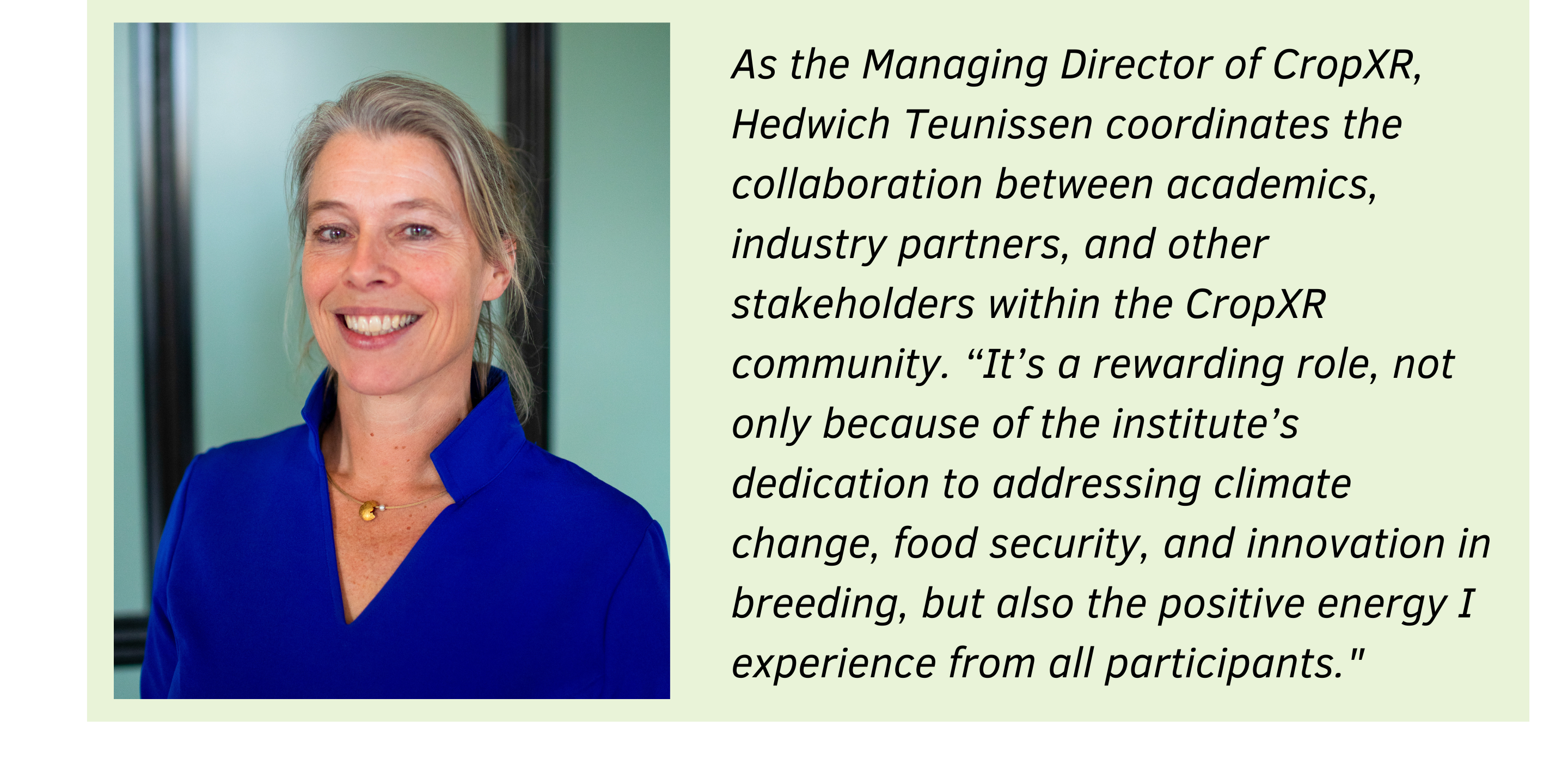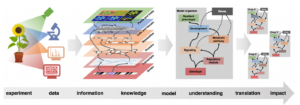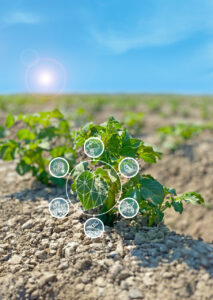9 April 2024
Advancing Smart Breeding for Resilient Agriculture
A Conversation with CropXR Managing Director Hedwich Teunissen
On the 29th of February, CropXR officially kicked off. This ambitious research institute aims to develop smart breeding technologies for sustainable and resilient crops and cropping systems. In this conversation with KeyGene, CropXR Managing Director, Hedwich Teunissen, shares insights into the institute’s focus, the science behind smart breeding, and the importance of collaboration and interdisciplinary efforts.

CropXR is an impressive initiative. How did this institute come about?
The institute’s focus is broad and ambitious: to enhance the resilience, sustainability, and climate adaptability of crops. Traditional breeding methods are great at producing high-yielding varieties. But these varieties often lack the resilience to withstand or recover from unexpected environmental changes. In fact, they often rely on intensive agricultural interventions like fertilizers and pesticides to withstand stresses and achieve a high-quality product and yield.
Subsequently, the question came up: how do we define and identify resilience? The only thing we know for sure is that resilience is complex. Resilience traits can’t simply be traced back to just one gene or a couple of genes, it’s much more complex than that. Recognizing that the complexity of a resilient phenotype goes far beyond singular genetic components, we understood we needed to look at our question from a systems biology perspective. Such a perspective considers the interconnected nature of the entire plant system.
CropXR’s main focus, therefore, evolved into constructing a smart breeding approach utilizing diverse data sets and advanced technologies such as artificial intelligence (AI), in order to define and predict resilience traits.
“We need crops with the capability to perform under greater stresses, without relying on outside interventions. In other words: we need resilient crops.”
Why is there a need for this?
The effects of climate change can be observed daily, also here in the Netherlands. For example, in Zeeland, a region in the southwest of the country. There, onion growers are facing problems with increased salination of the soil and reduced availability of fresh water. It has become so bad that some farmers have decided to move their onion cultivation elsewhere.
We’re living in a changing world, dealing with climate shifts. More and more, we need crops with the capability to perform under greater stresses without relying on outside interventions. In other words: we need resilient crops. To create these resilient crops, we need smart breeding solutions to deal with the complexity of resilience. And we need them fast.
Could you summarize CropXR’s plans and timeline?
Over the next ten years, we aim to develop a resilient crop, which will serve as a tangible proof of principle. We will do this in two phases. Our first five years will focus on understanding and leveraging data, modeling and AI to predict crop resilience. Data will be provided through hypothesis-driven research on Arabidopsis. This experimental data will be transformed into outcomes that will help us to understand the many processes in systems biology, such as the links between genotype, metabolic pathway, cells and tissues, and external stress. These outcomes will be applied to and tested out on our Flagship crop: the cauliflower. In the following phase, we will convert this fundamental knowledge into practical breeding tools for six crops: tomato, lettuce, onion, brassica, potato, and chrysanthemum. Thus, our plan for the coming decade is not only to develop smart breeding technology but also to ensure its successful application.

CropXR Research & Application Pipeline: From data to knowledge
Smart data from hypothesis-driven experiments is processed by bioinformatics and artificial intelligence and incorporated into mechanistic models that yield new insights and key regulators of plant resilience. These will be translated to other crop species.
How do you deal with the challenges surrounding data reliance?
Generating and using data poses a big challenge. The accuracy of models and predictions depends on the quality of the data. The quote ‘garbage in – garbage out’ in computer science is famous for a reason. The availability and use of high-quality data, tools, software, and knowledge generated within the consortium is, therefore, CropXR’s goldmine.
CropXR has the ambition to develop the ‘Resilience Hub’. With this, we’re aiming to create the world’s most extensive collection of knowledge, data, tools, and experts around the topic of crop resilience to power the accelerated design of resilient crops and unlock its value to the rest of the world.
To achieve this, we have a dedicated technology director for the data management. Furthermore, we build dedicated data infrastructure based on the FAIR principles (Findability, Accessibility, Interoperability Reusability) and ready it for the use of AI. We aim to make all our data available for everyone within the consortium.
“The breeder of the future will be a data-based plant designer.”
CropXR is not just about research, but also education, knowledge transfer, and communication. Could you tell us a bit more about all these different facets of the institute?
The art of breeding is going to change with a new generation of professionals and technologies. The breeder of the future will be a data-based plant designer. This professional has to be knowledgeable about many novel topics. So, it is important to start educating students on those topics now.
Knowledge transfer and communication are integral components of CropXR. They facilitate widespread understanding and implementation of our innovations, which is critical if we want to make a lasting impact in the breeding industry. Spreading the word will also help us to connect to breeders and farmers of smaller enterprises. At some point, we would like to welcome them into our community as well.

Crops can face multiple stressors. CropXR aims to unravel the resilience of crops to withstand such stressors.
So CropXR will extend its knowledge-sharing beyond its current supporters to benefit a broader audience?
Absolutely, because diversity is beneficial for the CropXR community, society, and the agricultural ecosystem. CropXR exists due to the investments of our academic and private partners, and the financial support of the Dutch Research Council (NWO) and National Growth Fund. As CropXR, we feel responsibility for both the economic impact on the earning capacity for the Dutch breeding industry and the societal impact on a more sustainable agricultural ecosystem. The current partners in CropXR are in the front seat to benefit from the knowledge, data, tools, and innovations to be developed. However, as CropXR community we would like to be open to new partners and collaborations. It’s not just the larger companies that play a pivotal role; breeders with smaller companies are equally significant in propelling progress. We aim for diversity and, in the end, for impact on agricultural ecosystems on a global scale.
Interestingly, you collaborate with a lot of the stakeholders; breeders use the technology, and academic institutions help to conduct the research. So why collaborate with technology innovation companies like KeyGene in this program? What’s the added value?
There is definitely an added value. Technology innovation is central to achieving CropXR’s goals. What makes KeyGene’s participation interesting is that its scientists operate on a super cutting-edge level of innovation, yet they’re still eager to jump on board with us. That tells us that this is a unique chance to unite the best minds and organizations.
We’re thrilled that technology innovation companies like KeyGene want to be part of CropXR. Their involvement adds real value to the entire institute, bringing in knowledge and expertise. It’s fantastic that they’re keen on sharing that within the CropXR community.
“Technology innovation is central to achieving CropXR’s goals.”
How does CropXR ensure that collaboration remains a driving force in achieving its goals, especially considering the diverse intentions of scientific organizations and companies?
Academic and industry organizations may indeed approach things differently, so it’s vital to emphasize and define precisely what we aim to deliver in the upcoming ten years. Ultimately, we all come together because we have a shared goal of creating more sustainable and resilient crops and cropping systems for the future. Our shared pursuit comes with a lot of passion and energy. Every partner has chosen to be part of this journey. Each one invests time and effort because this is something new and exciting that will probably have a great impact. The energy within this community is genuinely special.
It also sounds like it’s a unique opportunity to support a system change in breeding. To really be part of that next level of breeding.
Yes, so it’s great that KeyGene also believes in it. Together we can make it happen!
About CropXR
CropXR aims to leverage diverse data sets to construct models and integrate innovative technologies like artificial intelligence to be able to define and predict resilience. With that foundation, it aims to deliver practical and applicable breeding technologies, which can be used by breeders worldwide, leading to more sustainable and resilient crops. Currently, more than 15 companies and 4 universities contribute to the program, including KeyGene.
Find out more
- Want to find out more about CropXR? Visit their website here.
- Want to read more about the partnership between KeyGene and CropXR? You can read about it here.
- Want to speak to us directly about our work? You can contact us here.

